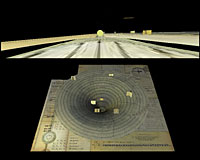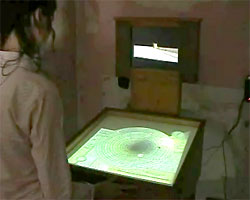Gallery: Chris Henschke
 HyperCollider simulation (11MB) Shockwave required |
 HyperCollider movie (8MB) QuickTime required |
HyperCollider
In 1905, Albert Einstein published his Special Theory of Relativity and overthrew the notions of absolute space and time. His later General Theory of Relativity was so revolutionary that even he had trouble accepting its full implications.
HyperCollider explores the extremes of relativity and how they disturbed Einstein's own cosmological philosophy of a balanced, logical, and eternal universe. It also plays with the unease that exists between the macroscopic worlds of relativity and the ultramicroscopic quantum universe, and the difficulties Einstein had with his colleagues' theories on quantum mechanics and its "uncertain" implications.

|
A collage of Einstein's relativity papers, handwritten notes, pressure graphs, and star charts is combined with a computer display running a simulation within a remade 1920s German pinball machine to make the HyperCollider exhibit. A hybrid of pinball game, gramophone player, and "particle accelerator," HyperCollider lets players launch various matter particles into a "theoretical universe." The particles collide with each other and get pulled into a black hole, which displays spatial contraction and temporal dilation effects. By bouncing particles into the black hole, players can move through time into an increasingly uncertain future, accompanied by a "pop-science-pop-music" soundtrack.
Text and art by Chris Henshke.
The project was created during Chris Henschke's time as the inaugural "online artist-in-residence" with the National Gallery of Australia in 2004 and was supported by the Film Victoria Digital Media Fund. HyperCollider is currently touring Australia and will be exhibited internationally in 2006. Visit www.topologies.com.au for details.

|
Click here to download the pdf version of this article.






